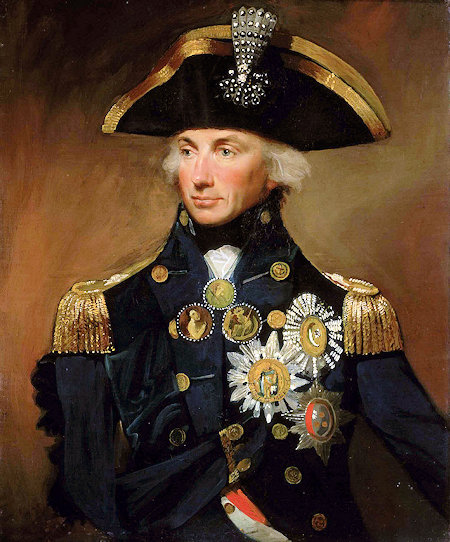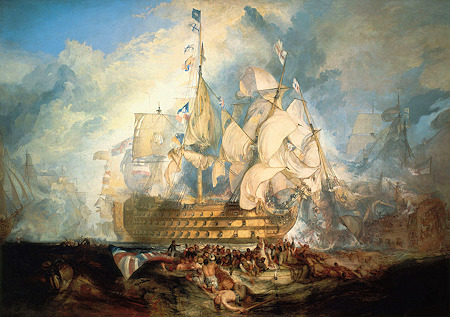Horatio Nelson
Vice-Admiral Horatio Nelson, 1st Viscount Nelson, 1st Duke of Bronté, KB (29 September 1758 – 21 October 1805) was a British flag officer in the Royal Navy.
His inspirational leadership, grasp of strategy, and unconventional tactics brought about a number of decisive British naval victories, particularly during the Napoleonic Wars. He was wounded in combat, losing sight in one eye in Corsica at the age of 36, and most of one arm in the unsuccessful attempt to conquer Santa Cruz de Tenerife when he was 40. He was fatally shot during his victory at the Battle of Trafalgar in 1805.
Nelson was born into a moderately prosperous Norfolk family and joined the navy through the influence of his uncle, Maurice Suckling, a high-ranking naval officer. Nelson rose rapidly through the ranks and served with leading naval commanders of the period before obtaining his own command at the age of 20 in 1778. He developed a reputation for personal valour and a firm grasp of tactics but suffered periods of illness and unemployment after the end of the American War of Independence.
The outbreak of the French Revolutionary Wars allowed Nelson to return to service, where he was particularly active in the Mediterranean. He fought in several minor engagements off Toulon and was important in the capture of Corsica and subsequent diplomatic duties with the Italian states. In 1797, he distinguished himself while in command of HMS Captain at the Battle of Cape St Vincent.
Shortly after that battle, Nelson took part in the Battle of Santa Cruz de Tenerife, where the attack failed and he was badly wounded, losing his right arm, and was forced to return to England to recuperate. The following year he won a decisive victory over the French at the Battle of the Nile and remained in the Mediterranean to support the Kingdom of Naples against a French invasion. In 1801 he was dispatched to the Baltic and won another victory, this time over the Danes at the Battle of Copenhagen.

Horatio Nelson; Portrait by Lemuel Francis Abbott
He commanded the blockade of the French and Spanish fleets at Toulon and, after their escape, chased them to the West Indies and back but failed to bring them to battle. After a brief return to England, he took over the Cádiz blockade in 1805. On 21 October 1805, the Franco-Spanish fleet came out of port, and Nelson's fleet engaged them at the Battle of Trafalgar. The battle became one of Britain's greatest naval victories, but Nelson, aboard HMS Victory, was fatally wounded by a French sharpshooter. His body was brought back to England where he was accorded a state funeral.
Nelson's death at Trafalgar secured his position as one of Britain's most heroic figures. The significance of the victory and his death during the battle led to his signal, "England expects that every man will do his duty", being regularly quoted, paraphrased and referenced up to the modern-day. Numerous monuments, including Nelson's Column in Trafalgar Square, London, and the Nelson Monument in Edinburgh, have been created in his memory, and his legacy remains highly influential.
![]() Reference and more information
Reference and more information

Battle of Trafalgar 1805; painting by JMW Turner




